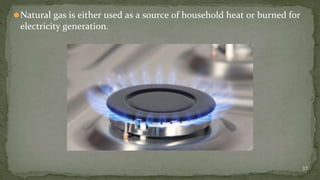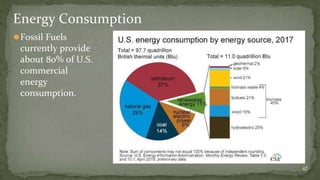Nonrenewable-Energy-Fossil-Fuels.pptxhshs
- 1. 1 Nonrenewable Energy - Fossil Fuels “Our civilization runs by burning the remains of humble creatures who inhabited the Earth hundreds of millions of years before the first humans…” - Carl Sagan
- 2. ⚫Nonrenewable energy resources are ones that do not replenish within the timeframe of human society. ⚫ Fossil fuels and nuclear power. ⚫Fossil fuels are forms of nonrenewable energy that arise from the remains of living organisms over millions of years. ⚫ Coal, oil, and natural gas. 2 Nonrenewable Energy
- 3. ⚫Coal is a hard, blackish substance that is formed from plant matter that has been highly compressed and pressurized. ⚫ When the organic matter is compressed, its carbon content increases, resulting in a greater energy content. 3 Coal
- 4. ⚫Most coal formed during the carboniferous era, which lasted from about 360-300 million years ago. 4
- 5. ⚫During the carboniferous period, much of the Earth experienced a tropical climate. ⚫ The average temperature was about 68°F, compared to an average of 55.5°F in the 20th century. 5
- 6. ⚫Fern-like trees evolved the ability to use a tough fiber called lignin to grow tall and stay upright, allowing them to outcompete neighboring trees for sunlight. ⚫ The trees had a shallow root system, causing them to fall over easily. ⚫ Bacteria and fungi had not yet evolved the ability to digest lignin, so dead trees did not decompose. ⚫The warm climate and invulnerability to insects and fungi significantly increased primary productivity of forests. 6 Drawing by Robert Krulwich
- 7. ⚫Over the next several million years, photosynthesis rates surpassed those of combustion and respiration, altering the carbon and oxygen cycles: ⚫ Atmospheric oxygen levels increased (from 21% to 35%) ⚫ Atmospheric carbon dioxide levels decreased (from 1500ppm to 350ppm) 7
- 8. ⚫The decrease in atmospheric carbon dioxide weakened the greenhouse effect, causing the global climate to become colder and a glacial expansion. 8
- 9. ⚫Modern coal deposits line up with the locations of largest carboniferous swamps – North America, Eastern Europe, and Asia. 9
- 10. ⚫Coal mining companies look for coal seams – layers of coal within rock that are thick enough to be profitably mined. ⚫ Surface mining techniques are used if the coal is not too deep underground. 10 Coal Extraction
- 11. ⚫Open-pit mining is where large holes are dug into the earth and the minerals removed. ⚫Strip mining actually carves away horizontal beds of coal deposit close to the surface. 11
- 12. ⚫Mountaintop removal uses explosives to blow up entire mountaintops to allow surface mining of coal seams underneath. ⚫ The dislodged soil and rock, called spoil, is deposited into nearby valleys ⚫ Mountaintop removal changes mountain ecosystems so much that it can be seen from satellite. 12
- 13. ⚫Subsurface, or underground mining, removes coal through deep tunnels and shafts. 13
- 14. ⚫Water can seep through coal mines, dissolving minerals and creating acid mine drainage. ⚫ Acidic, metallic, and toxic to many animals and plants. 14 Environmental effects of coal mining
- 15. ⚫Acid mine drainage is often rust-colored, due to the high iron content. 15
- 16. ⚫Workers in underground mines are exposed to high amounts of coal dust, which can eventually lead to black lung disease. 16 Normal lung tissue. Mild case of Black Lung disease. Severe case of Black Lung disease.
- 17. ⚫Oil is a carbon-rich liquid found within rock strata millions of years old. ⚫ Most oil deposits begin in warm shallow seas so productive that organic material formed faster than it could decompose. ⚫ The organic matter was buried, heated, and pressurized, becoming oil. 17 Oil
- 18. ⚫The present day distribution of oil generally lines up with those productive shallow seas. ⚫ Middle East, Western U.S. and Canada, Russia 18
- 19. ⚫Oil can be pumped directly out of the ground without the need for mining. ⚫ A long drill creates a borehole that is then lined with cement and steel. ⚫ Collection pipes and valves extract the oil. 19 Oil Extraction
- 20. ⚫The ease of transporting oil has enabled drilling at very remote locations. ⚫ Prudhoe Bay in Alaska, the Gulf of Mexico 20
- 21. ⚫As a liquid, oil can also escape more easily, forming an oil spill. ⚫Oil spills are devastating to marine life. 21
- 22. ⚫Oil penetrates through the fur and feathers of birds and mammals, reducing their ability to fly, float, and insulate themselves. ⚫Benthic organisms, living at the bottom of the sea, can be suffocated. ⚫Directly toxic to fish and plankton. 22
- 23. 23 Natural Gas ⚫Natural gas is a flammable mixture of gases, including methane (CH4). ⚫As a gas, it is more difficult to extract, contain, and transport. ⚫ Many oil drillers will burn off methane deposits instead of collecting them, creating a gas flare.
- 24. ⚫Hydraulic fracturing, or “fracking”, is a controversial technique used to extract natural gas from rock formations that are normally impermeable. ⚫ Shale is the most common rock that contains methane. 24 Hydraulic Fracturing
- 25. ⚫The Marcellus Shale is a large underground shale formation that contains an estimated 88 trillion cubic feet of natural gas. ⚫ Prior to 2008, these deposits were unknown. 25
- 26. ⚫First, a well is drilled down, then horizontally into the shale formation. ⚫A mixture of water and other chemicals called fracking fluid is pumped in. ⚫ The pressure created from this fluid causes the rock formation to fracture. ⚫Sand is injected afterwards to fill the cracks, because it is more permeable and allows the methane to seep out. 26
- 27. ⚫There are two big issues that make hydraulic fracturing controversial. ⚫ Millions of gallons of water are needed to “frack” the well. ⚫ The water that returns back to the surface, called flowback wastewater, is contaminated with minerals, fracturing fluid chemicals, and natural gas itself. 27 Water trucking containers, Dimock, Pennsylvania.
- 28. ⚫Hydraulic fracturing has been issued many exemptions from Federal environmental laws: ⚫ National Environmental Policy Act: Exempted from issuing certain environmental impact reports before drilling. ⚫ Clean Air Act: Exempted from emission limits passed in the 1990 amendments. ⚫ Clean Water Act: Exempted from pollution from stormwater runoff. ⚫ Safe Drinking Water Act: Exempted from a rule restricting underground injection of waste. ⚫ Resource Conservation and Recovery Act: Exempted from certain hazardous waste rules. 28 Water collected from a well in rural Bradford County, Pennsylvania.
- 29. ⚫Coal is primarily used as a source of heat for electricity generation. 29 Applications of Fossil Fuels Sahiwal Coal power project, Punjab, India.
- 30. ⚫The boiler burns coal, converting its chemical potential energy of coal into mechanical kinetic energy of steam. ⚫ Pollution is released by the stack. 30
- 31. ⚫Steam generated by boiling water is passed through a series of large fan blades called a turbine. ⚫ The kinetic energy of steam is converted to mechanical energy. ⚫A condenser cools the steam back into liquid water. 31
- 32. ⚫The spinning of the turbine blades spins a generator, which moves a magnet near a charged wire, generating an electric current. ⚫The electricity is delivered through a series of large transmission wires. 32
- 33. ⚫A cooling tower releases excess heat in the form of steam. ⚫ No actual air pollution is emitted, unlike the stack. 33
- 34. ⚫Coal plants are generally located near streams or bodies of water to ensure a constant supply of coolant water to replace the lost steam. 34 Oak Creek Power Plant, located near Milwaukee, Wisconsin.
- 35. ⚫The residual ash is mixed with water to minimize dust, then pumped into an ash storage pond. ⚫ The ash is highly toxic, containing heavy metals and other toxins. ⚫ Eventually, 70-80% of this ash is disposed of in landfills. The rest is used in concrete, asphalt, and other applications. 35 Power plant and coal ash ponds, Asheville, North Carolina.
- 36. ⚫Crude oil is separated in a process called distillation, where it is gradually heated and components are removed based on boiling point. ⚫ Low boiling point compounds, like gasoline, are removed first. ⚫The majority of the compounds derived from oil are used for transportation fuel. 36
- 37. ⚫Natural gas is either used as a source of household heat or burned for electricity generation. 37
- 38. ⚫Each fossil fuel has benefits and drawbacks as an energy source. ⚫In terms of pollution, coal is the dirtiest of the three fossil fuels, with natural gas being the cleanest. 38 Comparing Fossil Fuels
- 39. ⚫Energy returned on investment (EROI) is a ratio that measures the relative cost and difficulty of extracting a specific resource. ⚫ EROI = Energy returned / Energy invested ⚫ Lower ratios indicate that the resource is more difficult and expensive to extract. 39
- 40. ⚫The minimum EROI needed by an industrial society to function is 5-9. 40
- 41. ⚫The reserves-to-production ratio estimates how many of a resource we have left at current rates of use. ⚫ R/P Ratio = Total remaining reserves / Annual Rate of Production 41
- 42. ⚫Fossil Fuels currently provide about 80% of U.S. commercial energy consumption. 42 Energy Consumption









































